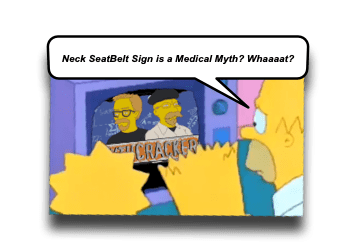Blunt Cerebrovascular Injury and “Seatbelt Sign”

There are many “medical myths” that require reconsideration from time to time (ex, cuffed ETTs). Some are less mythological and more misconceptions, misunderstandings, or just related to evolution of information and technology (ex, absorbable sutures for wound closure). This brings to mind one finding considered in management of the traumatize patient: “Seatbelt Sign.” We know of its significance with respect to blunt abdominal trauma and mesenteric injury as well as the potential for Chance Fractures, but does it also warrant concern when it is across the neck? Certainly, cervical injuries have appropriately captured our attention in the past (ex, C-Spine Clearance, C-Spine Injury, C-Spine Injury and Submersions, SCIWORA, Removing Helmet), but let’s now turn our attention briefly to the concern for Blunt CerebroVascular Injury:
Blunt Cerebrovascular Injury: Basics
Blunt Cerebrovascular Injury is a problem…
- Injury to the vertebral and/or carotid arteries
- Can cause intraluminal or intramural hematoma
- May lead to stenosis or occlusion
- Subsequently can cause ischemic or thrombotic stroke and death.
- (PMID 30429928: Uglade, 2018; PMID 29547069: Herbert, 2018)
- Early recognition may help initiate therapies expeditiously in an effort to prevent devastating sequelae.
- There is debate and a lot of institutional variability on the preferred management.
- Often involves anticoagulation.
- May involve stenting.
Fortunately, it is rare…
- The incidence varies based on studies, but often reported as involving 0.03 – 9% of pediatric patients seen for blunt trauma.
- (PMID 30429928: Uglade, 2018; PMID 29547069: Herbert, 2018)
Unfortunately, it is tricky to detect…
- Symptoms can be easily masked by other injuries
- Symptoms can be delayed (10 – 72 hours after injury)
- Simply irradiating children is generally not ideal
- (PMID 29547069: Herbert, 2018)
Blunt Cerebrovascular Injury: Screening
There is no unanimously agreed upon risk stratification tool for children
- EAST (Eastern Association for the Surgery of Trauma) guidelines note that pediatric risk factors are similar to that of adults. (PMID 30429928: Uglade, 2018)
- Most scoring systems focus on adults (not children) at high risk for blunt cerebrovascular injury (ex, Denver, Memphis). (PMID 29547069: Herbert, 2018)
- Utah score does focus on children: (PMID 29547069: Herbert, 2018)
- Weighs risk based on:
- GCS < 9 (1 pt)
- Focal Neurological Deficit (2 pts)
- Cerebral Infarction (3 pts)
- Carotid Canal Fracture (2 pts)
- Petrous Temporal Bone Fracture (3 pts)
- Low Risk = 2 or less points.
- May misclassify patients as low risk in 16.6% to 47.6% cases.
- Many misclassified had High-Impact mechanism of injuries.
- Weighs risk based on:
The McGovern Score may help as it factors in mechanism.
- No system is perfect, but currently the “best performing” screening tool is the McGovern Score:
- Scoring factors:
- GCS < 9 (1 pt)
- Focal Neurological Deficit (2 pts)
- Carotid Canal Fracture (2 pts)
- Mechanism of Injury = MVC or Automobile vs Pedestrian (2 pts)
- Petrous Temporal Bone Fracture (3 pts)
- Cerebral Infarction on CT (3 pts)
- Score of 3 or greater suggests utility of imaging (ex, CT Angio) for possible Cerebrovascular Injury.
- Score of less than 3, does not rule out the condition, but it would be reasonable to avoid reflexive vascular imaging and perform serial exams / observe.
- It is not perfect: has a sensitivity of 81% and specificity of 71%
- (PMID 29547069: Herbert, 2018)
- Scoring factors:
- So, if a patient has a concerning mechanism (ex, was a pedestrian struck by a vehicle) and you have concern for possible c-spine injury, if that patient has a focal neurologic finding or a GCS of 3-8, then it is reasonable to add CT Angio of the neck to your initial order.
- On the other hand, if that same patient as GCS of 14 and no other neurological findings, then you may need to wait to see what the other imaging results show in order to determine additional risk for blunt cerebrovascular injury.
But wait… what about Seatbelt Sign on the neck??
- Good question… and essentially, an isolated seatbelt sign is NOT associated with blunt cerebrovascular injury. (PMID 30429928: Uglade, 2018; PMID 24722311: Desai, 2014)
- EAST guidelines also do not recommend using isolated cervical seatbelt sign as an indication for CT angiography of the neck.
- When found on a patient who has clearly suffered from poly-trauma, then it may be reasonable to consider imaging, but a seatbelt sign without other symptoms or findings should not be the justification for reflexive CTA of the neck.
Moral of the Morsel
- The Rare does occur. This is why we remain vigilant.
- The Rare should not lead to irradiation of everyone with a neck. Obviously, this would lead to a lot of thyroid cancers.
- The Isolated Cervical Seatbelt Sign should not be the justification for ordering CT Angio. It needs to be noted and factored into the equation, but not given so much weight.
- Observation and/or good instructions is paramount! If you decide not to image the vasculature, remember that the injury may become apparently over the next 1-3 days.

